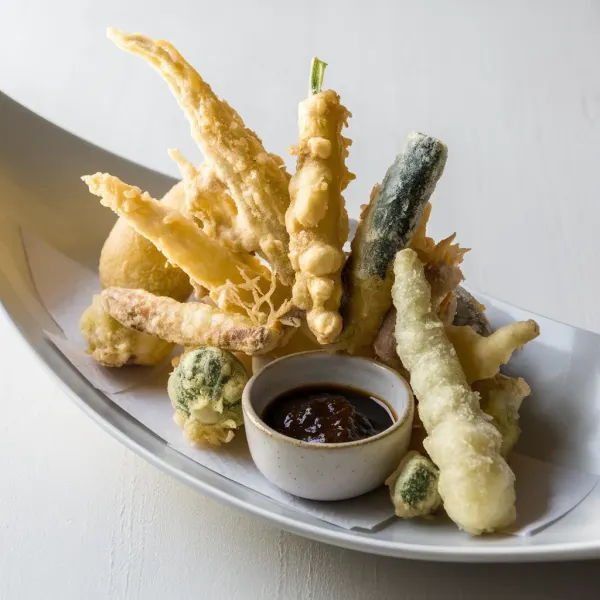
 25 minutes
25 minutesA delightful and crispy tempura made with assorted root vegetables, served with a rich umami tamari-kombu dipping sauce.


Carrots, washed, peeled, and cut into thin strips
0 oz
Sweet Potatoes, washed, peeled, and cut into thin strips
0 oz
Parsnips, washed, peeled, and cut into thin strips
0 oz
Tempura Batter Mix
0 oz
0 oz
0 oz
0 oz
Scallions, sliced
0 oz
0 oz
1. Prepare Vegetables
Begin by washing, peeling, and cutting your root vegetables into thin strips. This should take about 10 minutes and will give you an assortment of textures and flavors once fried.
2. Create Tempura Batter
Next, create the tempura batter by mixing the batter mix with ice-cold water in a bowl until smooth. The cold water is essential, as it helps the batter stay light and crisp when fried.
3. Heat Oil
Heat your oil to 350°F (175°C) in a deep fryer or a large pot. Use a thermometer to ensure the oil reaches the correct temperature, which is crucial for achieving that perfect crispy texture.
4. Fry Vegetables
Once the oil is ready, dip the vegetable strips into the tempura batter, making sure they are evenly coated. Using tongs or chopsticks, gently lower the battered vegetables into the hot oil. Fry them until they turn golden and crisp, which should take about 2-3 minutes per batch. You'll know they're ready when you see bubbles rapidly forming around the vegetables, indicating the batter is cooking properly.
5. Prepare Dipping Sauce
While the vegetables are frying, prepare the dipping sauce. Simmer tamari sauce with a piece of kombu in a small saucepan for 5-10 minutes, allowing the kombu to infuse its umami-rich flavor into the tamari.
6. Drain Excess Oil
Once the tempura vegetables are fried to perfection, use a slotted spoon to transfer them to a plate lined with paper towels to drain any excess oil.
7. Serve and Garnish
Arrange your tempura on a serving plate and accompany it with the tamari-kombu dipping sauce. For an added touch of flavor, garnish with sliced scallions or a sprinkle of sesame seeds.
The tempura batter should be cold and mixed minimally to keep the gluten development low, which results in a lighter, crispier coating. Some chefs even suggest using ice water or adding ice cubes to the batter to keep it cold.
Use a thermometer to maintain the oil temperature between 350°F and 375°F (175°C . 190°C). Too low, and the tempura absorbs too much oil and becomes greasy; too high, and it can burn. Fry in small batches to avoid overcrowding and temperature drops.
Choose a variety of root vegetables such as sweet potatoes, carrots, parsnips, and beets for a range of flavors and textures. Ensure they are fresh and firm, and cut them uniformly to ensure even cooking.
Tempura is best served fresh and hot. The longer it sits, the more it loses its crispness. Have your dip ready and your guests at the table as you fry the last batch.
Pat the vegetables dry after cutting them. Any excess moisture can cause the tempura batter to become soggy rather than crisp.




Comments (0)